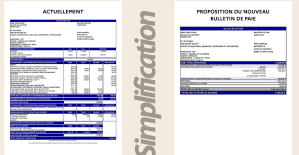With the arrival of autumn, the probability of a new wave of Covid-19 is increasing, as is the interest in a fourth dose. At the same time, a new generation of vaccines against Covid-19 could be authorized in France. Monday, September 12, the High Authority for Health will indeed issue an opinion on so-called "bivalent" messenger RNA vaccines. Manufactured by Moderna and Pfizer, these new vaccines target both the "historic" strain of the virus and that of its Omicron variant. There are two versions: the first activates protection against the original virus and against its subvariant Omicron BA.1, the second against the original virus and its subvariants Omicron BA.4 and BA.5. As Public Health France reminds us in its epidemiological bulletin of September 8, the BA.5 sub-variant represents 95% of cases in France.
In the meantime, the "historic" vaccines, if they do not or only slightly prevent the transmission of Omicron, remain very effective against serious forms, recalls the French Society of Pharmacology and Therapeutics, which cites numerous scientific studies. However, this protection decreases over time, particularly three months after the last injection. Inevitably, several questions come up: will bivalent vaccines offer higher or longer-lasting protection? Which version is the best? Should we wait for their marketing before injecting the fourth dose or not? Answer with Antoine Flahault, epidemiologist, director of the Institute of Global Health and professor at the Faculty of Medicine of Geneva.
L'Express: What to say to people at risk and those who are not, who wonder if they have to wait for the bivalent vaccines to receive the injection of a fourth dose?
The notion of "being at risk" is less simple than it might seem. If you mean "at risk of serious forms, hospitalizations and death", it is quite clear today that we are talking about people who are immunocompromised by their illness or their treatment, or even immunosenescent by their advanced age, or those who have not received at least three doses despite the presence of comorbidities (obesity, hypertension, diabetes, etc.). If we think of the risk of long, sometimes very disabling Covid, which seems to reach 10 to 20% of infected people, whether they have had a serious form or not, then it seems that we are all "at risk" of Covid long.
In all cases therefore, the fourth dose, that is to say the second booster, is highly recommended and without delay for all adults eligible for vaccination, and in priority to people at risk of serious forms. We should not wait for the availability of the bivalent vaccine, because we now know that people who have received four doses of monovalent vaccine are less often hospitalized than those who have received only three. For the bivalent vaccine, we do not yet have these data.
Is there nevertheless information allowing to evaluate the effectiveness of the new bivalent vaccines? Or who would determine the differences still between the BA.1 vaccines and compared to "historical" vaccines, and the advantages of the BA.4/BA.5 vaccines?
Today, we have no answers to these essential questions. Vaccine producers chase after the emergence of new variants and sub-variants. As soon as they produced their first bivalent vaccine with Omicron's BA.1 sub-variant, the BA.2 then BA.4 and BA.5 sub-variants appeared and quickly dominated the global landscape of this pandemic. They then released another bivalent formulation of their vaccines, containing strain BA.4 and BA.5.
But due to the short deadlines for having these new formulations available before the fall, they did not have the material time to conduct clinical efficacy trials. Thus the bivalent formulation BA.1 currently approved is mainly based on tests carried out in the laboratory (from neutralizing antibodies on human serum) and the bivalent BA.4-BA.5 has been approved by the Food and Drug Administration [FDA, the American drug agency, Editor's note] in the USA on the sole basis of efficacy trials conducted in rodents, in addition to studies on its safety in humans. This is also how the FDA authorizes seasonal flu vaccine reformulations. But the Covid is not the flu and we do not yet have enough hindsight to know if this strategy will prove conclusive.
If we have the choice, which will be the preferred vaccine, BA.1 or BA.4/BA.5?
Unfortunately, this question cannot yet be answered. Some experts believe, based on pre-clinical results, that bivalent vaccines will be more effective against Omicron transmission than conventional monovalent vaccines which were directed against only the original Wuhan strain. They could then limit the size of new waves. Others believe that these bivalent vaccines are likely to be a shot in the dark, calling the Omicron subvariants and in particular BA.5 "stealth variants", i.e. passing under the radar of our immunity, without leaving any immune memory, whether after an infection or a fortiori after a vaccination.
For my part, I think we have to wait for the first results of the North American real-life experiment since the FDA has decided to approve the bivalent BA.4/BA.5 vaccine and distribute it widely. The bivalent BA.1 seems to me a bit outdated today and might not appear much more effective than the original monovalent. The health authorities have in fact taken a gamble on the effectiveness of these new formulations, which the coming months will make it possible to assess.
How likely are new, completely different variants to emerge this fall/winter?
No one is able today to quantify the probability of the occurrence of future scenarios of this pandemic. Even in the medium term for next fall and winter. Is the rebound in contaminations noticeable in the last few days a harbinger of a new wave early in the season, when the summer wave is barely over? Is BA.5 able to cause a new wave like the Delta variant last year which caused an autumn wave shortly after its summer wave in Western Europe? Will a new sub-variant of Omicron succeed in qualifying and becoming dominant in turn? Will it replace BA.5 like BA.5 had replaced BA.2 which had itself replaced BA.1, or on the contrary will several sub-variants coexist this winter?
You see several possible scenarios here, not to mention more optimistic options such as a longer lull this fall or even a slightly high plateau but without a wave or hospital surge. But I am unable today to tell you which is the most likely!

 His body naturally produces alcohol, he is acquitted after a drunk driving conviction
His body naturally produces alcohol, he is acquitted after a drunk driving conviction Who is David Pecker, the first key witness in Donald Trump's trial?
Who is David Pecker, the first key witness in Donald Trump's trial? What does the law on the expulsion of migrants to Rwanda adopted by the British Parliament contain?
What does the law on the expulsion of migrants to Rwanda adopted by the British Parliament contain? The shadow of Chinese espionage hangs over Westminster
The shadow of Chinese espionage hangs over Westminster Colorectal cancer: what to watch out for in those under 50
Colorectal cancer: what to watch out for in those under 50 H5N1 virus: traces detected in pasteurized milk in the United States
H5N1 virus: traces detected in pasteurized milk in the United States What High Blood Pressure Does to Your Body (And Why It Should Be Treated)
What High Blood Pressure Does to Your Body (And Why It Should Be Treated) Vaccination in France has progressed in 2023, rejoices Public Health France
Vaccination in France has progressed in 2023, rejoices Public Health France The right deplores a “dismal agreement” on the end of careers at the SNCF
The right deplores a “dismal agreement” on the end of careers at the SNCF The United States pushes TikTok towards the exit
The United States pushes TikTok towards the exit Air traffic controllers strike: 75% of flights canceled at Orly on Thursday, 65% at Roissy and Marseille
Air traffic controllers strike: 75% of flights canceled at Orly on Thursday, 65% at Roissy and Marseille This is what your pay slip could look like tomorrow according to Bruno Le Maire
This is what your pay slip could look like tomorrow according to Bruno Le Maire Sky Dome 2123, Challengers, Back to Black... Films to watch or avoid this week
Sky Dome 2123, Challengers, Back to Black... Films to watch or avoid this week The standoff between the organizers of Vieilles Charrues and the elected officials of Carhaix threatens the festival
The standoff between the organizers of Vieilles Charrues and the elected officials of Carhaix threatens the festival Strasbourg inaugurates a year of celebrations and debates as World Book Capital
Strasbourg inaugurates a year of celebrations and debates as World Book Capital Kendji Girac is “out of the woods” after his gunshot wound to the chest
Kendji Girac is “out of the woods” after his gunshot wound to the chest Skoda Kodiaq 2024: a 'beast' plug-in hybrid SUV
Skoda Kodiaq 2024: a 'beast' plug-in hybrid SUV Tesla launches a new Model Y with 600 km of autonomy at a "more accessible price"
Tesla launches a new Model Y with 600 km of autonomy at a "more accessible price" The 10 best-selling cars in March 2024 in Spain: sales fall due to Easter
The 10 best-selling cars in March 2024 in Spain: sales fall due to Easter A private jet company buys more than 100 flying cars
A private jet company buys more than 100 flying cars This is how housing prices have changed in Spain in the last decade
This is how housing prices have changed in Spain in the last decade The home mortgage firm drops 10% in January and interest soars to 3.46%
The home mortgage firm drops 10% in January and interest soars to 3.46% The jewel of the Rocío de Nagüeles urbanization: a dream villa in Marbella
The jewel of the Rocío de Nagüeles urbanization: a dream villa in Marbella Rental prices grow by 7.3% in February: where does it go up and where does it go down?
Rental prices grow by 7.3% in February: where does it go up and where does it go down? Europeans: “All those who claim that we don’t need Europe are liars”, criticizes Bayrou
Europeans: “All those who claim that we don’t need Europe are liars”, criticizes Bayrou With the promise of a “real burst of authority”, Gabriel Attal provokes the ire of the opposition
With the promise of a “real burst of authority”, Gabriel Attal provokes the ire of the opposition Europeans: the schedule of debates to follow between now and June 9
Europeans: the schedule of debates to follow between now and June 9 Europeans: “In France, there is a left and there is a right,” assures Bellamy
Europeans: “In France, there is a left and there is a right,” assures Bellamy These French cities that will boycott the World Cup in Qatar
These French cities that will boycott the World Cup in Qatar NBA: the Wolves escape against the Suns, Indiana unfolds and the Clippers defeated
NBA: the Wolves escape against the Suns, Indiana unfolds and the Clippers defeated Real Madrid: what position will Mbappé play? The answer is known
Real Madrid: what position will Mbappé play? The answer is known Cycling: Quintana will appear at the Giro
Cycling: Quintana will appear at the Giro Premier League: “The team has given up”, notes Mauricio Pochettino after Arsenal’s card
Premier League: “The team has given up”, notes Mauricio Pochettino after Arsenal’s card


















